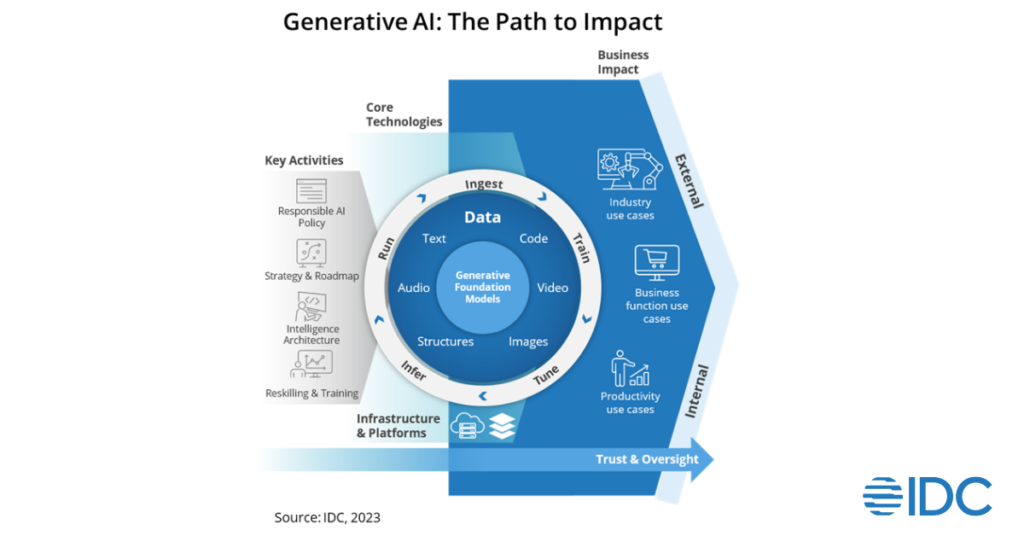The landscape of business may be seeing a seismic shift with the rise of Generative AI (Gen AI). This shift is not just the direct impact of Gen AI itself, but also how Gen AI is re-affirming the importance of AI overall and raising its profile within the business. This sea of change appears to be as tectonic as the PC revolutions of the ’80s and smartphones in the aughts. We are seeing the potential to revolutionize and disrupt industries, foster innovation, streamline operations, impact workforces, realize the promise of knowledge management, and democratize/consumerize AI in a remarkable fashion.
With this potential, it is important for organizations to navigate this transformation in a consistent, methodical, mindful fashion. This does not mean it has to be a slow laborious process, but it requires consideration to ensure responsible deployment and tangible/beneficial and scalable outcomes. This involves both technology and business stakeholders working together to quickly identify and implement short-term initiatives with a view towards longer-term imperatives and supportable environments.
Contaminated data can lead to incorrect models that fail to meet the desired outcomes. Addressing data quality, accuracy, and security challenges is a priority.
Daniel Saroff – Group Vice President of Consulting and Research

It Starts With Establishing a Foundation
Before embarking on the journey to harness the power of Generative AI, organizations need to establish a solid foundation. This foundation comprises several crucial elements:
1. Responsible AI Policy
A well-defined AI policy that outlines principles of fairness, transparency, accountability, and data protection is paramount. Ensuring explainability of AI model outputs and complying with legal/statutory regulations like GDPR are table stakes.
2. AI Strategy and Roadmap and the Role of the Proof of Concept
Crafting a comprehensive AI strategy with prioritized use cases is essential to aligning the organization’s efforts to business impact (both short and long terms).
The AI strategy should include the rules or guidelines for Gen AI proofs of concept (POCs), and it should incorporate the results of the POCs to recursively improve the strategy. This enables the strategy to self-correct and refine itself for a more successful, long-term approach, and facilitate responsive decision-making.
Many organizations don’t have the skills, policies, or data to leap into large/enterprise-changing Gen AI initiatives. With focused POCs, they have the opportunity for rapid action to identify skill, data, policy, and technology gaps in an efficient fashion. And with limited investment to prove out the technology.
To select POCs, use the following criteria for evaluation:
- Value: Economic, strategic alignment, risk
- Complexity: Data, algorithmic, system requirements, required ‘know-how’ or skills
For example, assess based on value, complexity, risk, data quality. If a proposal is high value but has poor data, don’t POC. Or if one is exceptionally high value and good data but high risk, wait until you’ve built experience in Gen AI.
Organizations should avoid over thinking their strategy and roadmap and thereby delay piloting this technology.
3. Intelligence Architecture
While Gen AI POCs do not need to build a platform to support enterprise Gen AI initiatives, part of their criteria for selection should be based on how they develop the understanding required for such a platform to exist. The architecture needs to consider how a platform can be implemented and governed, data models (structured, evaluated, integrated) required, and integration into existing systems.
Data privacy, security, and intellectual property protection must also be embedded within this platform architecture.
4. Reskilling and Training
Most organizations do not have mature skill-sets (prompt engineering, data science, data analysis, AI ethics, modeling) required to take full advantage of Gen AI. Nurturing a workforce equipped to build and use Generative AI models is a fundamental requirement. This requires hiring (which can be costly due to high demand roles) or reskilling.
Training should also be provided broadly across the organization. Due to its potential business impact, training all staff is important to create a baseline knowledge of the benefits and risks of the technology.
Implementing programs to assess organizational readiness is key to ensuring a smooth transition. This drives an understanding of the impacts on the organization and staffing, potential cultural inertia, and to proactively address staff concerns on its effects on their employment.
Data’s Crucial Role
Data serves as the foundation for Generative AI.
However, most organizations struggle with enterprise data. While business leaders often state that data is their most important asset, it is an asset that is frequently poorly curated, managed, understood, or analyzed. When IDC surveyed clients about their data, troubling results were revealed.
- 82% of organizations report siloed data (Future Enterprise Resiliency & Spending Survey)
- 41% cite that data is changing faster than they can keep up with (Global Data Valuation Survey)
- 24% do not trust their data (Future Enterprise Resiliency & Spending Survey)
- 29% have issues with data quality (Future Enterprise Resiliency & Spending Survey)
When assessing for POC selection, evaluate the data quality, ease of data retrieval/access, and integration as selection criteria. Where you have multiple POCs that can leverage decent quality, common data sets, select them over multiple POCs that require management of disparate data sets. There are enough challenges in the strategic leverage of Gen AI without adding data as another.
Security Concerns
Ensuring high-quality, accurate, and protected data is imperative. The integrity and privacy of data used to train AI models directly impacts their performance. Contaminated data can lead to incorrect models that fail to meet the desired outcomes. Addressing data quality, accuracy, and security challenges is a priority.
Impact on Infrastructure and Software Platforms
Generative AI’s adoption affects infrastructure and software platforms. For infrastructure the question of investment must be answered: whether to fund these investments via as-a-service models or via more traditional capital purchases. POCs can help drive the thought process for this decision making.
Software development lifecycles will accelerate, and low-code/no-code programming efforts will diversify code across AI-optimized architectures. This shift demands adaptable, API-enabled environments that balance portability, security, performance, cost control, and resilience.
Defining and Prioritizing Use Cases
Use cases are pivotal in driving the impact of Generative AI and strategy. Use cases typically fall into several categories:
- Industry-Specific: Tailored solutions, like generative drug discovery or material design, require customization and specialized data sharing. They can create substantial business value but demand unique models and integration and risk.
- Business Function: Integrating models with corporate data for specific departments (e.g., marketing, sales, procurement) needs careful data governance. Integration with established enterprise applications is crucial.
- Productivity: Basic use cases for productivity including summarizing across multiple reports to code generation to RFP template creation. They often integrate into existing applications as standalone SaaS solutions or cloud-based APIs. Gen AI may also be used to accelerate the meta tagging and categorization of enterprise data to improve data quality and retrieval. Additional productivity is gained through Gen AI’s unique ability to automate knowledge management through the synthesis of disparate data and sources across the enterprise. Knowledge management was largely unsuccessful in the first decade of this century, because it asked people to work differently. Gen AI allows knowledge productivity without staff changing their work habits.
Engage your C-Suite and key leaders in collaborative sessions to uncover relevant use cases and design a realistic roadmap. Also, provide a mechanism for capturing ideas that organically bubble up from divisions or lines of business.
Think Through Your Vendor Partner Selection Carefully
In the rapidly evolving landscape of Generative AI, there’s considerable ambiguity surrounding the technology and its practical applicability. Despite this uncertainty, a few key insights have begun to crystallize, especially regarding the usage of publicly-shared foundation models and the role of cloud platform providers.
According to IDC’s recent survey, cloud platform providers are perceived as the most strategic technology partners for GenAI initiatives.
Cloud providers deliver publicly-shared foundation models, often as PaaS or SaaS, that will find their place within a subset of enterprise use cases. While these may deliver short-term advantage, they are a commodity so are unlikely to provide long term competitive advantage. For most organizations, lasting benefit comes from leveraging finely-tuned, domain-specific models accessible in a private or controlled manner – a current example being Microsoft’s strategic investments in generative AI technologies making it a strong contender in this space.
In the same survey, IT consultants and system integrators emerged as a strong second. They are poised to guide organizations through the complex journey of Gen AI implementation. Organizations need to determine how well and long to use these partners.
As an initial driver for change, they are valuable. Consultants and systems integrators provide skills and tools in short supply in many enterprises, but in the long run, if it is a competitive advantage (versus necessity), developing those skills and capabilities internally drives greater sustainable benefit.
Conclusion
Navigating the world of Generative AI requires an approach that encompasses responsible policies, sound data practices, technology understanding, a comprehensive view of use cases, and collaboration between IT and business leadership. Develop POCs with an eye to how they can help you create a consistent and defensible Gen AI moat for your organization, which can grow and evolve as strategy and competitive pressures demand. And be ready for a wild ride!




